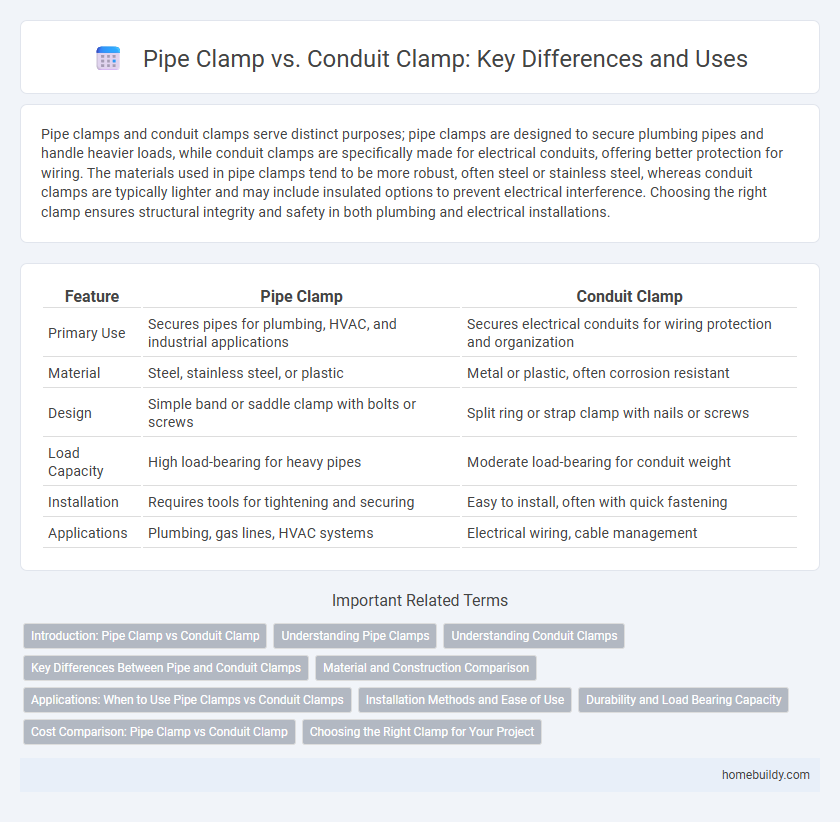Pipe clamps and conduit clamps serve distinct purposes; pipe clamps are designed to secure plumbing pipes and handle heavier loads, while conduit clamps are specifically made for electrical conduits, offering better protection for wiring. The materials used in pipe clamps tend to be more robust, often steel or stainless steel, whereas conduit clamps are typically lighter and may include insulated options to prevent electrical interference. Choosing the right clamp ensures structural integrity and safety in both plumbing and electrical installations.
Table of Comparison
| Feature | Pipe Clamp | Conduit Clamp |
|---|---|---|
| Primary Use | Secures pipes for plumbing, HVAC, and industrial applications | Secures electrical conduits for wiring protection and organization |
| Material | Steel, stainless steel, or plastic | Metal or plastic, often corrosion resistant |
| Design | Simple band or saddle clamp with bolts or screws | Split ring or strap clamp with nails or screws |
| Load Capacity | High load-bearing for heavy pipes | Moderate load-bearing for conduit weight |
| Installation | Requires tools for tightening and securing | Easy to install, often with quick fastening |
| Applications | Plumbing, gas lines, HVAC systems | Electrical wiring, cable management |
Introduction: Pipe Clamp vs Conduit Clamp
Pipe clamps secure cylindrical pipes using robust metal bands or brackets, providing strong support for plumbing and industrial applications. Conduit clamps specifically fasten electrical conduits, ensuring electrical cables are protected and organized while preventing movement. Both clamps vary in design and material to suit their distinct purposes, with pipe clamps focusing on fluid or gas transport and conduit clamps tailored for electrical systems.
Understanding Pipe Clamps
Pipe clamps provide secure and adjustable support for pipes, ensuring stability and reducing vibration in plumbing and industrial applications. Unlike conduit clamps designed specifically for electrical conduits, pipe clamps accommodate various pipe materials and sizes, offering versatile installation options. Understanding pipe clamps involves recognizing their role in maintaining pipe alignment, load distribution, and ease of maintenance in fluid and gas transport systems.
Understanding Conduit Clamps
Conduit clamps are specifically designed to secure electrical conduit pipes, providing robust support and preventing movement that could damage wiring. Unlike general pipe clamps, conduit clamps often feature insulation or coatings to protect against electrical conduction and corrosion. Understanding conduit clamps is essential for ensuring compliance with electrical codes and maintaining safe, efficient conduit installations.
Key Differences Between Pipe and Conduit Clamps
Pipe clamps are typically designed for securing round pipes carrying fluids or gases, featuring a robust structure to handle heavier loads and vibrations. Conduit clamps primarily support electrical conduits, emphasizing insulation and protection against electrical interference while maintaining a lightweight, corrosion-resistant design. The key differences lie in their material composition, load capacity, and application-specific features tailored to piping systems versus electrical conduit installations.
Material and Construction Comparison
Pipe clamps are typically made from robust materials like stainless steel, galvanized steel, or cast iron, designed to withstand high pressure and heavy loads, ensuring secure pipe support in plumbing and industrial applications. Conduit clamps, often constructed from lighter metals such as aluminum or plastic, prioritize flexibility and corrosion resistance to protect electrical conduit systems. The construction of pipe clamps emphasizes durability and strength with thicker materials and reinforced designs, while conduit clamps focus on ease of installation and insulation properties suitable for electrical conduit protection.
Applications: When to Use Pipe Clamps vs Conduit Clamps
Pipe clamps are ideal for securing heavy-duty pipes in plumbing, HVAC systems, and industrial applications due to their robust design and ability to bear significant weight. Conduit clamps suit electrical conduit installations, providing secure attachment and protection for wiring in residential, commercial, and industrial settings. Selecting between pipe clamps and conduit clamps depends on the specific requirements of load capacity, material type, and environmental conditions.
Installation Methods and Ease of Use
Pipe clamps are typically installed using screws or bolts that secure the clamp around a pipe, providing a strong and stable hold ideal for heavier pipes. Conduit clamps often feature a simpler installation process with snap-on or hinged mechanisms designed for quick attachment to electrical conduits, enhancing ease of use in wiring projects. The choice between the two depends on the specific application requirements, with pipe clamps offering more durability and conduit clamps delivering faster installation.
Durability and Load Bearing Capacity
Pipe clamps are typically constructed from robust materials like stainless steel or heavy-duty plastic, offering superior durability compared to conduit clamps, which are often made from lighter metals or plastic. The load bearing capacity of pipe clamps is significantly higher, designed to secure heavy pipes in industrial and plumbing applications, whereas conduit clamps are generally intended for lighter electrical conduits. This distinction in materials and design ensures pipe clamps provide enhanced strength and longevity under heavy loads.
Cost Comparison: Pipe Clamp vs Conduit Clamp
Pipe clamps generally offer a lower initial cost compared to conduit clamps due to simpler materials and manufacturing processes. Conduit clamps often incorporate specific features for electrical grounding and insulation, leading to higher prices. Selecting between pipe clamps and conduit clamps depends on the application requirements and budget constraints.
Choosing the Right Clamp for Your Project
Pipe clamps provide robust support for plumbing pipes, offering secure fastening and vibration dampening essential for fluid transport systems. Conduit clamps are specifically designed to hold electrical conduits, ensuring safety and compliance with electrical codes by preventing conduit movement and potential wire damage. Choosing the right clamp depends on the application requirements, load capacity, and material compatibility, making pipe clamps ideal for plumbing and conduit clamps best for electrical installations.
Pipe clamp vs Conduit clamp Infographic

 homebuildy.com
homebuildy.com